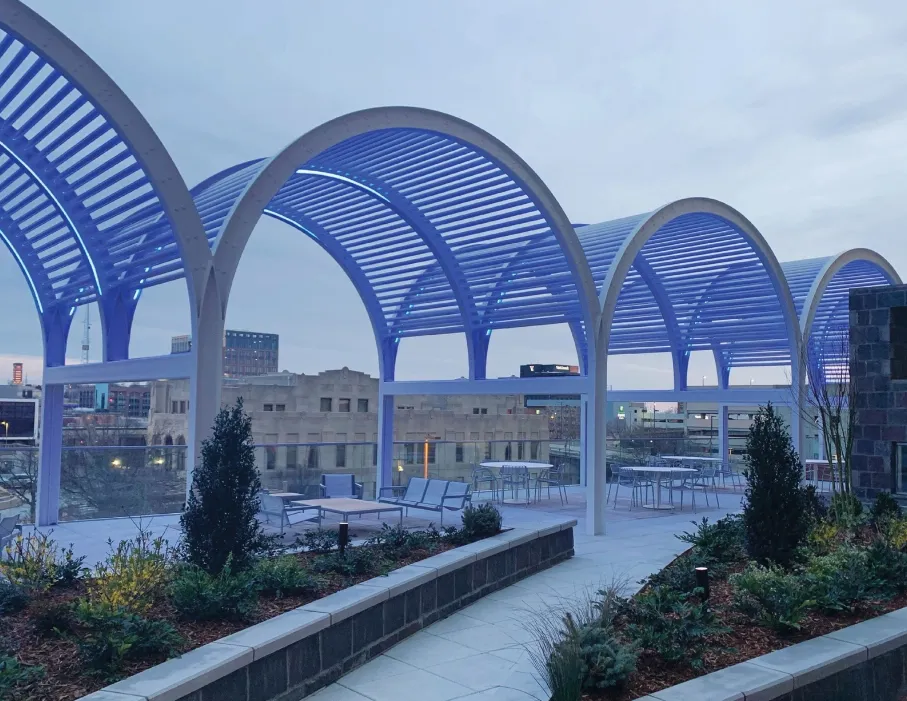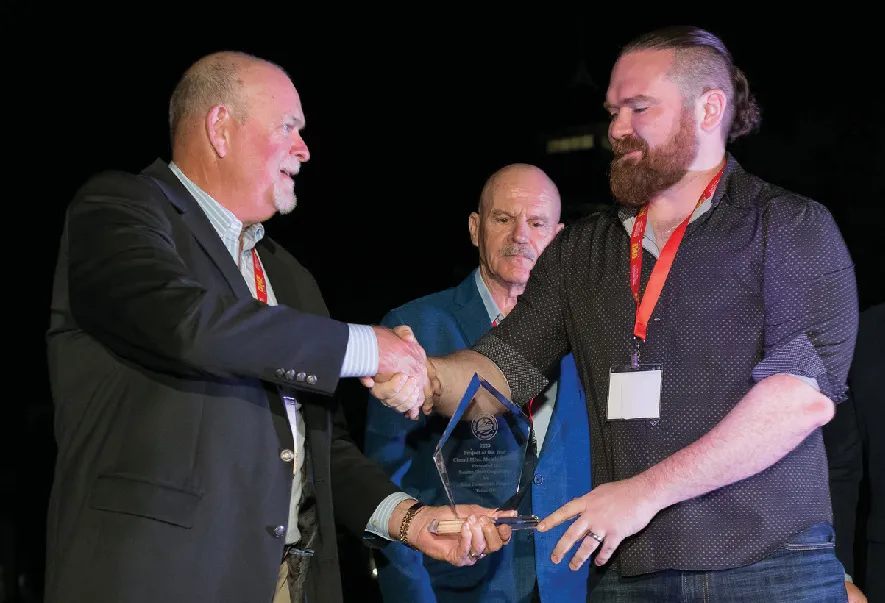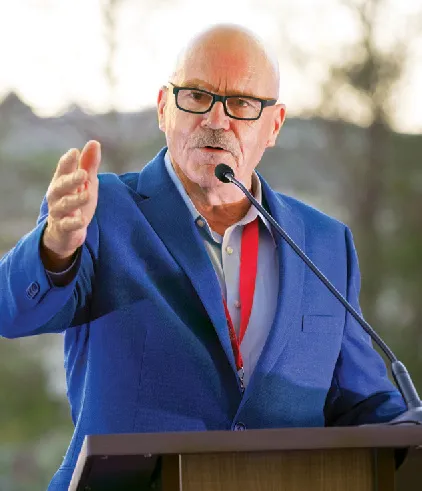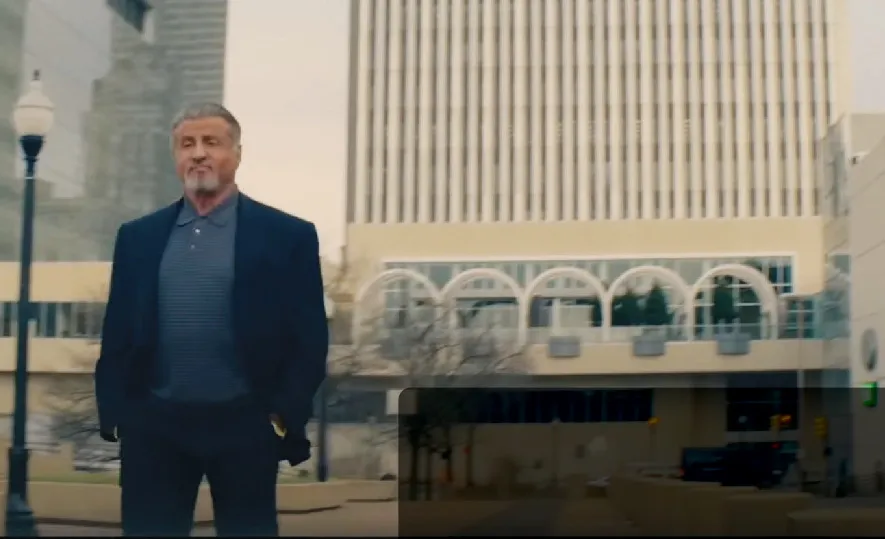Beneath the ‘skin’ of America’s infrastructure, ironworkers and steel fabricators work in concert to assemble and raise its skeleton frame

Above: The massive pergola project in downtown Tulsa, Oklahoma, was designed, fabricated and erected in less than four months
November 2023- Beneath the ‘skin’ of America’s infrastructure, ironworkers and steel fabricators work in concert to assemble and raise its skeleton frame
In October 1871, a fire broke out on the southwest side of Chicago, consuming 17,500 buildings, 73 square miles of city streets and killing approximately 300 people. One in three Chicago residents were left homeless. In the days following the fire, the city created stricter building regulations that dictated the use of non-combustible materials such as brick and stone. And as Chicago recovered and then rapidly expanded, city building officials and architects turned to steel as the most effective way to raise taller buildings.
The 10-story Home Insurance Building, completed in 1885, is commonly believed to be the first structure to use a steel skeleton frame with reinforced concrete and is considered the first modern skyscraper.
That project paved the way for Chicago’s Rand McNally Building, the first allsteel framed skyscraper erected in 1890. Prized for its versatility and high tensile strength, steel has served as the backbone of America’s cities throughout the 20th century. Today nearly 95 percent of all commercial buildings use steel framing. Steel erectors or ironworkers are mission essential to the successful completion of a construction project. These individuals assemble metal framework by fitting together steel girders, hollow tubing and beams. They bring the detailed plans of architects and engineers to life by creating, installing, placing, aligning and reinforcing steel structures and frameworks at great heights in myriad weather conditions.
RAISING STEEL
“The steel erection business is a meshing of high tech and old-world craftsmanship,” says David Deem, president of Deem Structural Services LLC and the Steel Erectors Association of America (SEAA). “We can share information digitally. Personnel in the field can carry a tablet and get the input they need in real time. Paper blueprints will likely be nonexistent at some point. But ironworkers still have to walk on steel and use hand tools to install components like bolts.”
Deem has spent more than 30 years in the steel business in Longview, Texas. He operated Deem Steel Erectors, East Texas Erectors and was vice president of operations for Peterson-Beckner Industries. Deem has belonged to SEAA for more than 25 years and served as a board member for 15 years. He was appointed president of the association in 2022.

Basden built the pergola’s arches on its production floor because they had to be individually assembled at street level before being lifted into place
The Occupational Safety & Health Administration was established in 1971 and largely drove formation of the Steel Erectors Association of the Carolinas. The non-profit was founded by a group of North and South Carolina companies to give small rebar contractors and erectors a voice. In 1992, national expansion prompted the organization to change its name to Steel Erectors Association of America. In 2022, the group marked its 50th anniversary.
SEAA is the only national trade association that represents the interests of steel erectors, fabricators, general contractors and related service providers. The association promotes safety, education and training programs for the industry, including its Ironworker Craft Training curriculum. Its Fabricator Training Module features construction math, hand and power tools, how to read detailed drawings, rigging equipment and practices, welding safety, quality, symbols and oxyfuel cutting.
Steel fabricators process raw materials into workable shapes. Precision is key. If the final products don’t meet blueprint requirements, they cannot be used. Specifications must be accurately coded into CNC software. If a project calls for a profile with a unique shape, the fabricator must also be skilled at using computer-aided design software to hand draw a part. The relationship between fabricators and erectors is symbiotic.

Arches were lifted and leveled into place on the building’s second floor terrace
ADDING VALUE
“Most erectors, including myself, work for the fabricator,” says Deem. “Typically, once an architect designs a building, the general contractor sources a fabricator. The fabricator selects the erector. That’s how we like it. The ability to work upfront with the fabricator at the pre-planning stage gives us the opportunity to evaluate things like connection configurations, erection and safety aids that can then be built into a project’s design. You want a quality product that is both economical and safe to build. If you don’t get in upfront on a project, you have to live with what you get.”
Under Deem’s two-year term, SEAA’s efforts have largely been focused on activities that add value to members such as expanding safety-related videos and products. Another priority is to help members navigate the supply chain more effectively and network with other professionals. The biggest challenge, Deem notes, is recruiting new people.
“The average steel erector is 45 years old,” he says. “The construction market needs manpower. We’ve been working for a long time to change perceptions about our industry. We are beginning to see some positive movement among young people who are starting to show some interest. Steel erection is not for everyone. It’s hard work. But if you like it and are a student of your industry, you will be successful.”
SEAA has held career fairs where students interact with crane and welding simulators to judge whether it piques their interest. “The industry isn’t dying, it’s dying for people,” Deem adds. “You won’t run out of opportunities in the construction business. We’ve worked at better defining career paths from recruiting people to providing a safe work space, training and developing a roadmap for advancement and growth.”
Austin Jones, contract administrator for Basden Steel Corp., agrees. Jones, Deem’s stepson, got his first taste of the industry as a laborer for Deem Steel Erectors. “My first promotion was to steel painte. I worked my way up to the raising gang foreman. Th at’s ironworker slang for the guys that rig the cranes.”
SAFETY FIRST
In 2014, Jones went to work for Basden in Burleson, Texas, as an estimator before advancing to his current position.

Austin Jones, right, accepts the award for the Miscellaneous Metals Class I category from Bob Beckner, moderator for SEAA’s Project of the Year panel discussion. David Deem looks on.
The employee-owned company provides steel erection and fabrication services to much of the Midwest. With locations in Dallas, Houston and Tulsa, Basden can provide detailing and modeling, advanced planning and coordination and pre-bid services. Its fabrication facilities offer capabilities ranging from CNC robotic technology for beam and angle lines, automatic layout, plasma coping and cutting to shot blasting and painting. The company acquired Deem Structural Services in 2012 to bring erection services in house.

Basden is American Institute of Steel Construction (AISC) certified as well as an American Welding Society-certified weld inspector. The company also has a Zero Accidents Safety Program.
“In 2020, the U.S. Department of Labor identified ironworking as one of the most dangerous jobs in the country,” Jones says. “We are always looking at ways to keep safety at the forefront of each project.”
Basden’s erection and fabrication skills were showcased in April 2023 when the company won the Miscellaneous Metals Class I category in an annual competition held by SEAA. The project, a massive pergola erected in downtown Tulsa, was one Basden nearly turned down.
A building developer wanted a pergola to shade a newly renovated cafe. The design called for a 100- ft .-long structure consisting of five arches. Architecturally exposed structural steel (AESS) was used to deliver striking visual impact. Galvanized, white painted 10-in. wide-flange beams were used to create the columns and arches. The columns and bearings for the center arches were connected with high-strength steel. Each arch is 18 ft . tall and 20 ft . wide.

The pergola project completed by Basden, photo-bombed filming of Sylvester Stallone’s TV series “Tulsa Kings.
FRAMEWORK
Initially, “we declined the project because there were several challenges,” Jones says.
Painting over galvanized steel can be problematic because the galvanized metal has a layer of zinc to retard corrosion. Zinc also makes it difficult for paint to adhere. In addition, the base plate required multiple full penetration welds.
Timing and location also presented obstacles. The project was slated to start at the onset of winter and is located in a high-traffic area. According to the U.S. Census Bureau, Oklahoma’s population is growing faster than the majority of the country. Downtown traffic is often congested.
“The general contractor called us a second time and asked us to take a look at the project,” says Jones. “We bid on it and got it.” Jones was assigned Oklahoma field operations manager.
That meant he had to wear a number of hats, including fabrication estimator/ manager and erector estimator/manager. “The first thing we did was sit down with the design team to get an understanding of their vision for the finished project,” he continues. “There can sometimes be a disconnect between what the architect thinks it should look like and the engineer’s understanding of what it should look like. We made some design changes. For example, we moved the splices to maintain better continuity. We went over finishings with them. They wanted something that would stand the test of time. We chose galvanized SP17, sand blast and epoxy primer with zinc. These weathering agents allow the seal to last longer.”
Basden also performed several model renderings of the structure’s connections in 3D to confirm that all parties shared the same understanding of final appearance.
“As a fabricator, it’s an advantage to have an in-house erector,” says Jones. “That’s the Basden model. We prefer to erect our own steel because it promotes better coordination. We already have a relationship with the erection/ connection engineers so we can build our own standard operating procedures and made sure the elements are in place on a job that the erector wants to see.”
The pergola’s arches had to be built on Basden’s production floor because they had to be assembled individually at street level before being lifted into place. Basden’s fabrication shop performed a test fit on the domes that would sit atop the arches. Operators created a numbering system to keep track of multiple pieces with the same part number. Four to five pipes were bunched together and pre-welded so the arches could be picked up as frames. After ensuring that all weld holes went in the same direction, tubes were tack welded to splice plates and the plates bolted to wide-flange beams. Bolting parts together prior to welding allowed Basden to account for heat distortion while making sure the pipes held their shape during galvanizing.
Developing an erection sequence was the next step. A Terex AC 140 all-terrain crane with a 53-ft . lift ing radius and a boom that could extend approximately 100 ft ., was chosen to lift and level arches into place.
SOLVING FOR X
“After several reviews of the erection plan that included site visits for field dimensions and coordination with the general contractor and other trades, we thought we had accounted for everything,” Jones says.
Shortly before the installation date, the Basden team discovered that information provided by the general contractor for crane placement had not been field-verified. “We planned to leave the crane on the sidewalk and one lane of the street, so that the other lanes could still support traffic,” he continues. “The superintendent Sean Carter and I noticed a manhole about 5 ft . from where one of the crane’s outriggers would be placed. A service tunnel was located directly below where we planned to place the crane. We had to push the equipment out into the street, which meant shutting down a busy thoroughfare.”
Basden was also hampered by city restrictions. Crews could not swing the crane during rush hour before 9 a.m. or after 4 p.m.
“That meant we could only work from 9 a.m. to 3:30 p.m.,” Jones says. “The city also didn’t want us to swing steel over weekends, so on Friday, we had to de-mobilize the crane, remove it from the site, then reverse the process on Monday.”
Other complications included making connections seamless, which required welding, sanding and weld cleanup. Coordination of very small openings in the steel for lighting was also required.
The project was designed, fabricated and erected in less than four months. Despite its bumpy start, Jones notes that the job has since become one of his favorite projects. “It pushed me to learn more about coordination and communication and how to look ahead and anticipate different scenarios,” Jones says.
He also acknowledges the invaluable takeaways he gained from the field experience of Deem and Ben McGregor, vice president- Oklahoma division for Basden.
Ironworkers and fabricators play a crucial role in the nation’s infrastructure, helping to build new steel structures and rehab older ones. Teamed with forward thinking organizations like SEAA, Deem, Jones and the men and women who make up the construction industry are helping to shape the future.
Basden Steel Corp., 817/295-6100, http://basdensteel.com/
Steel Erectors Association of America, 336/294-8880, http://seaa.net/











